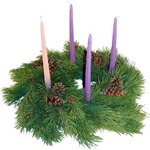The History of the Advent Wreath
Posted By RichC on December 3, 2009
While doing a little research on the Advent Wreath for family devotions this past weekend, I came across an interesting article that I wanted to share  and archive. Although I’m not Catholic, one would have thought I would have known a bit more about the pre-Christian and pre-Protestant history. I’ll include a couple paragraphs from the article about ‘symbolism’ below, but the entire article is posted here. (I’ll be anxious to see if this link makes it to a friends’ “Bookmarks I made today” list?)
and archive. Although I’m not Catholic, one would have thought I would have known a bit more about the pre-Christian and pre-Protestant history. I’ll include a couple paragraphs from the article about ‘symbolism’ below, but the entire article is posted here. (I’ll be anxious to see if this link makes it to a friends’ “Bookmarks I made today” list?)
😉
The actual origins are uncertain. There is evidence of pre-Christian Germanic peoples using wreathes with lit candles during the cold and dark December days as a sign of hope in the future warm and extended-sunlight days of Spring. In Scandinavia during Winter, lighted candles were placed around a wheel, and prayers were offered to the god of light to turn “the wheel of the earth” back toward the sun to lengthen the days and restore warmth.
The symbolism of the Advent wreath is beautiful. The wreath is made of various evergreens, signifying continuous life. Even these evergreens have a traditional meaning which can be adapted to our faith: The laurel signifies victory over persecution and suffering; pine, holly, and yew, immortality; and cedar, strength and healing. Holly also has a special Christian symbolism: The prickly leaves remind us of the crown of thorns, and one English legend tells of how the cross was made of holly. The circle of the wreath, which has no beginning or end, symbolizes the eternity of God, the immortality of the soul, and the everlasting life found in Christ. Any pine cones, nuts, or seedpods used to decorate the wreath also symbolize life and resurrection. All together, the wreath of evergreens depicts the immortality of our soul and the new, everlasting life promised to us through Christ, the eternal Word of the Father, who entered our world becoming true man and who was victorious over sin and death through His own passion, death, and resurrection.
The four candles represent the four weeks of Advent. A tradition is that each week represents one thousand years, to sum to the 4,000 years from Adam and Eve until the Birth of the Savior. Three candles are purple and one is rose. The purple candles in particular symbolize the prayer, penance, and preparatory sacrifices and goods works undertaken at this time. The rose candle is lit on the third Sunday, Gaudete Sunday, when the priest also wears rose vestments at Mass; Gaudete Sunday is the Sunday of rejoicing, because the faithful have arrived at the midpoint of Advent, when their preparation is now half over and they are close to Christmas. The progressive lighting of the candles symbolizes the expectation and hope surrounding our Lord’s first coming into the world and the anticipation of His second coming to judge the living and the dead.
The light again signifies Christ, the Light of the world. Some modern day adaptions include a white candle placed in the middle of the wreath, which represents Christ and is lit on Christmas Eve. Another tradition is to replace the three purple and one rose candles with four white candles, which will be lit throughout Christmas season.
ACKNOWLEDGEMENT
Saunders, Rev. William. “The History of the Advent Wreath.” Arlington Catholic Herald.
Reprinted with permission of the Arlington Catholic Herald.
THE AUTHOR
Father William Saunders is dean of the Notre Dame Graduate School of Christendom College and pastor of Our Lady of Hope Parish in Sterling, Virginia. The above article is a "Straight Answers" column he wrote for the Arlington Catholic Herald. Father Saunders is also the author of Straight Answers, a book based on 100 of his columns and published by Cathedral Press in Baltimore.
http://www.catholiceducation.org/articles/religion/re0132.html
Comments